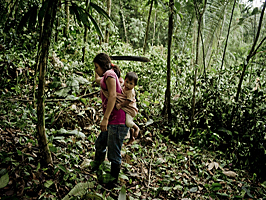 Latin America, Africa & Asia: Community Forests and Their Peoples Need Enhanced Protections
Latin America, Africa & Asia: Community Forests and Their Peoples Need Enhanced Protections
By Rebecca S. Myles (Esta dirección de correo electrónico está siendo protegida contra los robots de spam. Necesita tener JavaScript habilitado para poder verlo.)
A new report argues that expanding and strengthening the community forest rights of indigenous and rural people in Latin America, Africa and Asia can lead to less deforestation and contribute to lower carbon dioxide emissions.
The report "Securing Rights, Combating Climate Change," sponsored by the World Resources Institute and Rights and Resources Initiative, studied 14 forest rich countries including, Bolivia, Brazil, Columbia, Ecuador, Guatemala, Honduras, Indonesia, Mexico, Nepal, Nicaragua, Niger, Papua New Guinea, Peru and Tanzania.
When indigenous people and local community have no or weak legal rights, their forests are deforested and contribute to carbon dioxide emissions, which "contributes 11 percent to annual global greenhouse gas emissions." When their rights are enforced were more successful at stopping loggers, extractive companies and settlers from illegally destroying the forests and releasing carbon pollution into the atmosphere.
"Every head of government, minister and climate negotiator should pay attention to this important, if often overlooked strategy to address climate change," said Dr. Andrew Steer, President and CEO, World Resources Institute.
Indigenous and rural peoples currently only have legal and official rights to at least 513 million hectares of forests, representing about one eighth of the world's total.
"No one has a stronger interest in the health of forests than the communities that depend on them for their livelihoods and culture," said Andy White, Coordinator of Rights and Resources Initiative. "It's tragic that this has not yet been fully adopted as a central climate change mitigation strategy. For us to get serious about curbing climate change, we have to get serious about respecting the rights of local communities to the lands they live and depend on."
The report presents examples of what happens without protections and without them. In northwestern Peru, government supported oil, mining and mineral exploitation in the Peruvian Amazon covers three quarters of the region, despite the indigenous peoeples having community forest rights. This decision has lead to deforestation rates of 24-51 percent during a 10-year period.
In Papua New Guinea, despite all the forest being owned by communities, the government gave leases to private companies for oil palm plantations on 4 million hectares.
But where protections are in place and enforced, on parts of the Mexican Yucatan, deforestation rates are 350 times lower than in unprotected areas, the report said. And in Guatemala's Peten region, deforestation rates are 20 times lower.
In Brazil which has half of the world's remaining tropical forests, where 300 indigenous territories have been recognized their deforestation rates are 11 times lower than in other areas of the Brazilian Amazon. The report argues if indigenous territories in Brazil were fully protected that could prevent 27.2 million hectares from being deforested by 2050 and prevent 12 billion tons of carbon dioxide from being released.
There are five recommendations for governments to follow in strengthen the rights for community forests residents: give communities legal recognition of their forest rights; rigorously enforce those rights with mapping boundaries and evicting trespassers like illegal settlers and loggers; provide residents with technical assistance to manage their forests; involve the communities in decision bout their forests; and compensate communities for benefits provided by their forests for mitigating climate change.
LATIN POST - USA - 27 julio 2014
